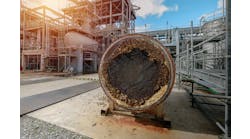Customers often asked Jake, “Should I performance test this new piece of equipment?” Jake’s standard response: “Are you doing energy studies or do you want to make sure the vendor supplied what you paid for?” The term “performance testing” was, among Jake’s customers, widely used to cover all testing of equipment. When it came to new equipment, performance tests always were called for, but rarely was acceptance testing called out.
[pullquote]
Acceptance testing is used to confirm the vendor met contract requirements. Usually, equipment suppliers will add a little extra to the price if testing is part of the specification. It carries a legal responsibility and the requirement for accurate testing.
Jake had tested lots of equipment over the years. His mentor, Mac, had drilled into him the difference between the two types of tests. Mac had been part of a society measurement taskforce and had written numerous papers on measurement accuracy. As a result of Mac’s and the committee’s work, field performance/acceptance testing had been displaced by factory test stand acceptance/performance testing.
Site acceptance testing (SAT) posed multiple problems. Even though Mac and Jake specified proper locations for temperature, pressure and flow measurement, often the drawing would state, “Field construction to locate.” This resulted in poor placement of the thermowells and bizarre locations for flow measurement. Project engineers poorly understood performance measurement; oftentimes when project cost became an issue, the measurement systems were eliminated. Installing devices after the project was complete became expensive — Mac and Jake often fought uphill battles to get them installed. Mac brought the accuracy of thermowell location to light when he researched and field tested the stratification of flows. A thermowell too close to an elbow varied measurements by as much as 1.5°F. Because the specification for the test demanded accuracy within ± 0.1°F, this variation was simply unacceptable.
Getting the specified flows and temperatures in the field also posed issues. By the time the piece of equipment was installed, it was an operating unit — making adjusting the specified load and flow on it challenging. The balance of temperatures became nightmarish. In some cases, project engineers would install a false load heat exchanger to enable maintaining accurate load. Most energy engineers will recognize the problems this caused when these heat exchangers were left in place.
Some manufacturers recognized the problem and began installing certified test stands to perform acceptance testing or performance testing once the equipment was built. The test stands were set up with straight runs for flow orifices and thermowells. Accurate test resistance temperature detectors (RTDs) or thermistors were installed in the test loops and all measurements run to a common data collection system that could give accurate live performance. The flow loops were configured so flows and temperatures were set and maintained at specifications. Machine on-board instrumentation helped verify against the certified test stand so engineers could check field inconsistencies once the equipment was installed. In addition, Jake and Mac started requiring an operating range performance test to optimize and integrate equipment into their energy management plan. This helped determine heat exchanger fouling and other problems at off-design conditions.
As a result of the gradual improvements in acceptance testing, online performance testing became easier. RTDs and thermistors replaced thermometers. Flow measurement devices were calibrated and then characterized, meaning routine anomalies were built into the analysis. Instrumentation synced to energy and process management systems to provide immediate access to a full analysis.
If you are buying a new piece of equipment, here are a few suggestions:
Decide if you want an acceptance test.
Write in to the specifications that an acceptance test will be performed. Find out if a certified test stand is available from the manufacturer.
It’s critical to ensure that you and the project team are on the same page. The usual cost of a factory acceptance test (FAT) is nominal, but it is an identifiable item on the project and might be eliminated at the last moment.
If an SAT is needed, make sure the project team, the vendor and you are in agreement. Determine the limits of the measurement accuracy for each sensor. You must reach a consensus with the vendor on what constitutes meeting the specifications based on these accuracies. Verify that the project team understands the importance of sensor location and accuracy of the sensors installed. While you can upgrade inaccurate sensors in the field, changing the locations for these sensors usually is difficult.
In the end, you are trying to make sure that you are getting the equipment performance for which you paid. Be firm with the project team and the vendor.
Active in both, the American Society of Mechanical Engineers and the American Society of Heating, Ventilating, Refrigerating, and Air-Conditioning Engineers (ASHRAE), Clark was chairman of ASHRAE's task group on Halocarbon Emissions and served on the committee that created ASHRAE SPG3 - Guideline for Reducing Halocarbon Emissions. He has written numerous papers on CFC alternatives and retrofitting CFC chillers. He was awarded a U.S. patent on a method for reducing emissions from refrigeration equipment. He has served as technical resource for several others.


